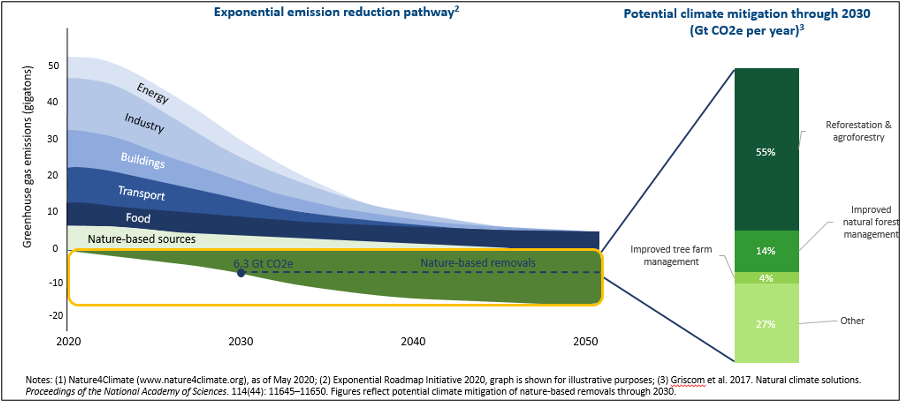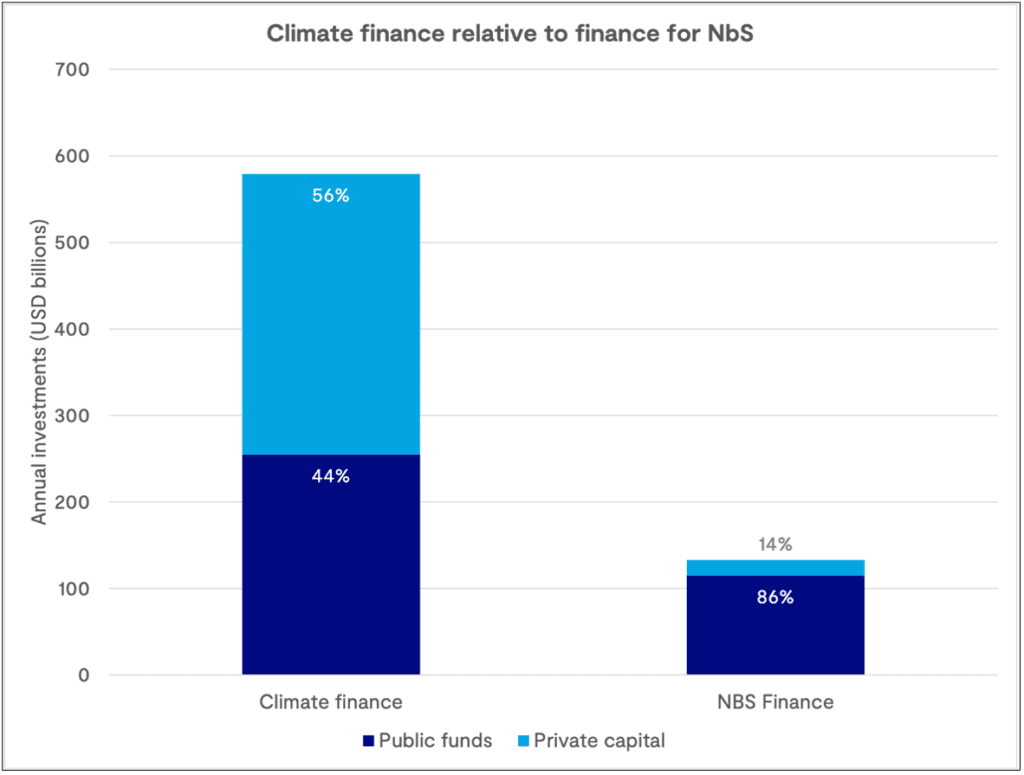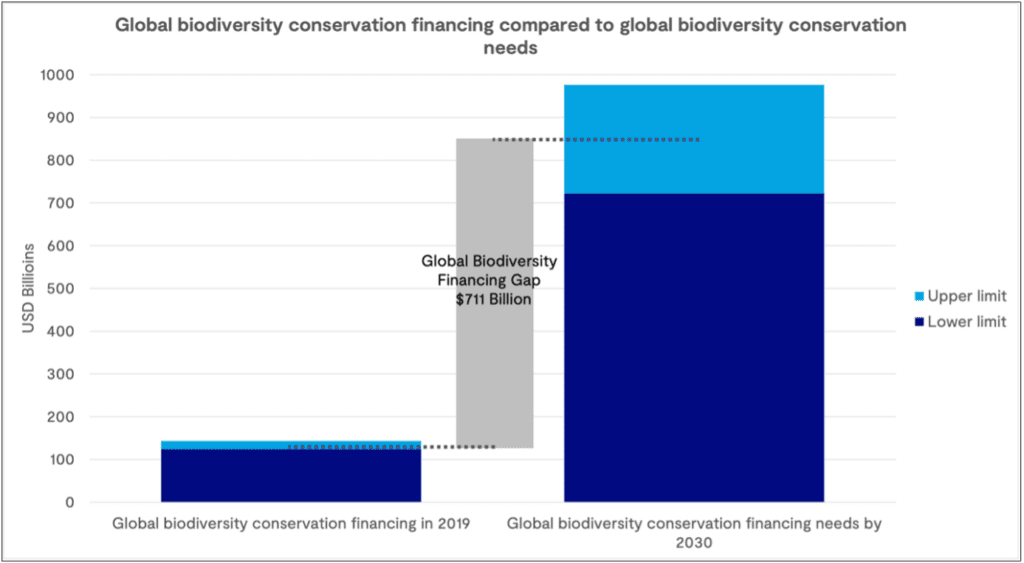In this explainer, the Timberland Investment Group explains the meaning of natural capital, as well as the benefits of investing in natural capital.
What is Natural Capital?
The simple definition of natural capital is the earth’s stock of natural resources, ecosystems, and environmental services that provide valuable benefits to human beings. The idea of viewing nature as natural capital, in an effort to recognize the true value that it provides, is increasing in popularity. Despite the term’s origin in the 1970s, there is a now a mounting chorus advocating for natural capital to be recognized as an economic asset (natural capital accounting) including the United Nations, which has urged governments to expand their perspective beyond GDP.[1]
| Examples of Natural Capital Natural capital is essential for supporting all life on the planet and is the foundation for economic and social well-being. It encompasses elements such as forests, rivers, oceans, minerals, clean air, biodiversity, and the overall functioning of ecosystems. It plays a crucial role in providing vital resources, regulating climate, purifying water, pollinating crops, mitigating natural disasters, and offering recreational and cultural opportunities. – Forests: Forests provide a range of ecosystem services such as carbon sequestration, timber, non-timber forest products, wildlife habitat, and water regulation. – Freshwater resources: Rivers, lakes, and aquifers serve as natural capital by providing clean water for drinking, irrigation, and industrial purposes. – Oceans and marine ecosystems: Coastal areas, coral reefs, and marine habitats are valuable natural capital for their biodiversity, fish stocks, coastal protection, and tourism potential. – Biodiversity: The diversity of species, genes, and ecosystems constitutes natural capital, contributing to ecosystem resilience, pollination, pest control, and potential discoveries of new medicines. – Soil and agricultural land: Fertile soils and productive agricultural land are vital natural capital for food production, supporting livelihoods, and economic activities. – Clean air and climate regulation: The atmosphere acts as natural capital by providing clean air to breathe and regulating climate patterns, influencing temperature, precipitation, and weather conditions. – Wetlands: Wetlands, including marshes, swamps, and mangroves, are natural capital that helps regulate water flow, filter pollutants, and provide habitat for diverse species. |
What are natural climate solutions?
The link between natural capital and natural climate solutions lies in the shared objective of addressing climate change through the conservation, restoration, and sustainable management of natural ecosystems. Natural capital refers to the earth’s stock of natural resources and environmental services, which includes the capacity of ecosystems to absorb and store carbon dioxide, regulate climate patterns, and provide other climate-related benefits. Natural climate solutions, on the other hand, are specific strategies that leverage the power of nature to mitigate greenhouse gas emissions and enhance resilience to climate change. These solutions often involve activities such as reforestation, afforestation, wetland restoration, sustainable agriculture, and improved land management practices. By investing in natural capital and implementing natural climate solutions, it is possible to simultaneously reduce carbon emissions, enhance carbon sinks, protect biodiversity, improve water resources, and promote sustainable development.
Are forests natural capital? Can they be a natural climate solution?
Yes, to both. Forests are one of the most critical ecosystems on our planet, covering approximately one-third of the Earth’s landmass. They are home to most terrestrial species, and they provide a wide range of ecosystem services, such as carbon sequestration, water regulation, and soil conservation. They are also home to diverse communities and support the livelihoods of millions of people worldwide, including indigenous peoples.
| Snapshot: the benefits of forests to people, climate, and biodiversity[2] About 33 million people – 1 percent of global employment – are estimated to work directly in the formal and informal forest sector. The sector contributed (directly, indirectly and induced) more than $1.52 trillion to world gross domestic product in 2015 (latest data available). Trees and forests are major means for combating climate change. Forests contain 662 billion tonnes of carbon, which is more than half the global carbon stock in soils and vegetation. Despite a continued reduction in area, forests absorbed more carbon than they emitted in 2011–2020 due to reforestation, improved forest management, and other factors. Forests provide habitat for 80 percent of amphibian species, 75 percent of bird species and 68 percent of mammal species, and tropical forests contain about 60 percent of all vascular plant species. |
The world’s forests, however, have long been under threat. Since 2000, annual rates of tree cover loss have risen and an estimated 11% of tree cover has been lost.[3] The resulting impact has been catastrophic for biodiversity, which is declining faster than at any time in human history. Deforestation and land-use change are responsible for roughly a quarter of global greenhouse gas emissions.[4]
Protecting the forests we have, restoring those that have been degraded, and growing new forest resources are all critical to mitigating and adapting to climate change, preserving biodiversity, and developing sustainable economic livelihoods.
What are the climate benefits of forests?
Forests play a crucial role in regulating the Earth’s climate by sequestering and storing carbon dioxide from the atmosphere. It has been estimated that the world’s forests sequestered about twice as much carbon dioxide as they emitted between 2001 and 2019, providing a ‘carbon sink’ that absorbs a net 7.6 billion metric tonnes of CO2 per year, one and a half times more carbon than the United States emits annually.[5]
Forest conservation, restoration, and management are among the most significant natural climate solutions (NCS) – a portfolio of land use activities that avoid greenhouse gas emissions and increase carbon storage. Research shows that NCS could provide approximately one-third of the climate mitigation needed by 2030 to keep global warming below 2°C, in line with the Paris Agreement, with forests providing nearly 75% of this total.[6]
Among the various NCS pathways, reforestation provides the single greatest opportunity to mitigate climate change, followed by forest protection and improved management. Crucially, reforestation also offers the potential for carbon removals by absorbing carbon from the atmosphere in rapidly growing young trees, rather than simply avoiding new emissions. Reforestation represents the only large-scale carbon removal technology that can be readily deployed today, enabling low-cost, scalable, and highly feasible action. Reforestation not only increases the amount of carbon sequestered but can also improve biodiversity and the quality of soil and water in the ecosystem. It can also generate economic benefits for forest-dependent communities.

What other ecosystem benefits do forests provide?
As highly complex ecosystems, forests are also critical for maintaining biodiversity. They are home to most terrestrial species and contain approximately 80% of the world’s terrestrial biodiversity.[7]
Deforestation and forest degradation lead to the loss of species and ecosystems, accelerating the current biodiversity and climate crises. Forest restoration and good management practices can help to restore habitat for endangered species, improve habitat connectivity, prevent further biodiversity loss, and improve ecosystem resilience through practices such as thinning and fuels reduction. By securing the participation of local communities in forest restoration programs, forests can be brought back to health in ways that secure durable benefits for people and nature.
Forests also deliver critical ecosystem services that support human well-being and economic growth. Forests can support temperature regulation, groundwater infiltration, and soil retention. In contrast, deforestation releases carbon to the atmosphere, and can increase soil erosion, reduce water quality, and increase risk of species extinction. Forests can also play important roles in regulating regional climate. For example, in both the Amazon Basin and the Brazilian Cerrado, deforestation is also associated with a reduction in rainfall that could threaten the survival of the entire forest ecosystem.[8] Where deforestation has occurred, forest restoration has the potential to restore these critical ecosystem functions.
What benefits do forests provide to local communities, including Indigenous peoples?
Forests also play a vital role in supporting the livelihoods and cultures of people all over the world. They are home to 300 million people[9] – farmers, hunter-gatherers and others who live on the land – and, in addition, it is estimated that more than 1.6 billion people’s livelihoods depend on forests for timber, food, fuel, and jobs.[10]
For many rural communities and indigenous peoples, forest resources lie at the center of social, political, and economic life and form the primary source of community livelihood, nutrition, and employment.
Forest products provide essential food, water, nutrients, and medicines for rural populations, keeping many people out of extreme poverty. For people located in these areas, almost one-quarter of their income can derive from forest sources – a contribution which is greater than that of wage labor, livestock, self-owned businesses, or any other category aside from crops.[11]
Rural economies in many countries are supported by the forest industry, creating jobs and wealth for populations where there are few alternative options. Forests produce more than 5,000 types of wood-based products, and generate annual gross value-added of just over $600 billion, about 1% of global GDP – and in some countries that contribution is much higher.[12]
Benefits for people are not only economic, but may also be social, cultural, and spiritual. A range of religions and faiths are connected to trees, plants, forests, and animals. Forests and wildlife are a source of community tradition, folklore, and spirituality. Traditional forest-related knowledge, that has accumulated over thousands of years, is profoundly linked to the cultures of many indigenous and forest-dependent communities. And growing bodies of research point to the profound benefits of exposure to forests and nature for mental and emotional health.
Natural Capital Investment
What is the role of private finance for investing in natural capital and natural climate solutions? Natural capital in economics, business and investing.
Despite the range of climate, biodiversity, and social benefits that forest restoration and protection can provide, there is a substantial finance gap between what is needed to deliver these benefits and what is being provided now. It has been estimated that the financing gap to reverse the decline in biodiversity by 2030 is between $598 billion and $824 billion per year (US$711 billion per year on average).[13] It is increasingly clear that private finance, delivered from non-governmental sources, has a vital role to play in bridging the gap, given that financing for nature-based solutions amounts to just approximately $154 billion today.[14]
The private sector is increasingly aware of the value of nature for businesses and society. According to the World Economic Forum, $44 trillion of value (over half of the world’s GDP) is generated in industries that depend highly ($13 trillion) or moderately ($31 trillion) on nature and its services.[15] But it is not just sensitivity to risk that is driving corporate action: there is also fast-growing awareness of the commercial opportunities which nature-based investments offer. It has been estimated that a new nature economy could generate $10 trillion in business value and create 395 million jobs by 2030.[16]

Source: Vivid Economics, as shown by ‘Capital for Climate’. 2020. (https://nbs.capitalforclimate.com/netzero/thenbsinvestmentlandscape)

Source: ‘Financing Nature: Closing the Global Biodiversity Funding Gap’. 2019. (Nature-Based Solutions Investment (capitalforclimate.com)
What is TIG’s approach to natural capital investment?
TIG believes that forest protection, restoration, and commercial reforestation can make a vital contribution to tackling the twin challenges of climate change and biodiversity loss, while delivering positive social impact. Planting more trees and protecting those we have can help to tackle some of the most pressing environmental and social challenges we face.
Specifically, TIG is pioneering a strategy that combines climate positive commercial forestry, carbon and environmental services from tree farms, as well as the restoration and protection of forests. Additionally, downstream investments into the bioeconomy can create opportunities for natural capital investment, potentially providing commercial returns to investors and fostering economic development for rural communities. This approach aims to attract private capital.
Integrated investment in protection, restoration, and commercial tree farms across landscapes offers the greatest opportunity in our view to achieve financial performance and to deliver positive outcomes for people, climate, and nature. Investment in alignment with a clear strategic vision can deliver social, climate, and biodiversity benefits that are mutually reinforcing, creating a virtuous circle of action that delivers durable and far-reaching benefits.
[1] United Nations. “UN adopts landmark framework to integrate natural capital in economic reporting.” Accessed November 13, 2023.
[2] FAO. 2022. “The State of the World’s Forests 2022.”
[3] WRI. “Global Forest Review: Forest Loss.” Accessed November 13, 2023.
[4] EPA. “Global Greenhouse Gas Emissions Data.” Accessed November 13, 2023.
[5] WRI. “Global Forest Review: Forest Loss.” Accessed November 13, 2023.
[6] Griscom, B. et al. 2017. Natural climate solutions. Proceedings of the National Academy of Sciences. 114(44): pages 11645– 11650.
[7] UNEP. “UNEP and Biodiversity.” Accessed November 13, 2023.
[8] Rodrigues, et al. 2022. “Cerrado Deforestation Threatens Regional Climate and Water Availability for Agriculture and Ecosystems.” Global Change Biology. Lovejoy, T. and C. Nobre. 2019. Amazon tipping point: last change for action. Science Advances. 5(12).
[9] UN. 2011. “Forests for People: Factsheet.”
[10] UN Department of Economic and Social Affairs. 2020. “Forests – a Lifeline for People and Planet.”
[11] World Bank. 2020. “Forests for People, the Planet and Climate.”
[12] Li, Y.S., Mei B. and Linhares-Juvenal, T. 2019. “The Economic Contribution of the World’s Forest Sector.” Forest Policy and Economics.
[13] UNEP. 2022.” State of Finance for Nature. Time to act: Doubling investment by 2025 and eliminating nature-negative finance flows.”
[14] Ibid
[15] World Economic Forum. 2020. “Why the crisis engulfing nature matters for business and the economy”.
[16] World Economic Forum. 2020. “The Future of Nature and Business.”
